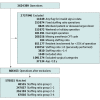Association of Anesthesiologist Staffing Ratio With Surgical Patient Morbidity and Mortality
- PMID: 35857304
- PMCID: PMC9301588
- DOI: 10.1001/jamasurg.2022.2804
Association of Anesthesiologist Staffing Ratio With Surgical Patient Morbidity and Mortality
Abstract
Importance: Recent studies have investigated the effect of overlapping surgeon responsibilities or nurse to patient staffing ratios on patient outcomes, but the association of overlapping anesthesiologist responsibilities with patient outcomes remains unexplored to our knowledge.
Objective: To examine the association between different levels of anesthesiologist staffing ratios and surgical patient morbidity and mortality.
Design, setting, and participants: A retrospective, matched cohort study consisting of major noncardiac inpatient surgical procedures performed from January 1, 2010, to October 31, 2017, was conducted in 23 US academic and private hospitals. A total of 866 453 adult patients (aged ≥18 years) undergoing major inpatient surgery within the Multicenter Perioperative Outcomes Group electronic health record registry were included. Anesthesiologist sign-in and sign-out times were used to calculate a continuous time-weighted average staffing ratio variable for each operation. Propensity score-matching methods were applied to create balanced sample groups with respect to patient-, operative-, and hospital-level confounders and resulted in 4 groups based on anesthesiologist staffing ratio. Groups consisted of patients receiving care from an anesthesiologist covering 1 operation (group 1), more than 1 to no more than 2 overlapping operations (group 1-2), more than 2 to no more than 3 overlapping operations (group 2-3), and more than 3 to no more than 4 overlapping operations (group 3-4). Data analysis was performed from October 2019 to October 2021.
Exposure: Undergoing a major inpatient surgical operation that involved an anesthesiologist providing care for up to 4 overlapping operations.
Main outcomes and measures: The primary composite outcome was 30-day mortality and 6 major surgical morbidities (cardiac, respiratory, gastrointestinal, urinary, bleeding, and infectious complications) derived from International Classification of Diseases, Ninth Revision and International Statistical Classification of Diseases and Related Health Problems, Tenth Revision discharge diagnosis codes.
Results: In all, 578 815 adult patients (mean [SD] age, 55.7 [16.2] years; 55.1% female) were analyzed. After matching operations according to anesthesiologist staffing ratio, 48 555 patients were in group 1; 247 057, group 1-2; 216 193, group 2-3; and 67 010, group 3-4. Increasing anesthesiologist coverage responsibilities was associated with an increase in risk-adjusted surgical patient morbidity and mortality. Compared with patients in group 1-2, those in group 2-3 had a 4% relative increase in risk-adjusted mortality and morbidity (5.06% vs 5.25%; adjusted odds ratio [AOR], 1.04; 95% CI, 1.01-1.08; P = .02) and those in group 3-4 had a 14% increase in risk-adjusted mortality and morbidity (5.06% vs 5.75%; AOR, 1.15; 95% CI, 1.09-1.21; P < .001).
Conclusions and relevance: This study's findings suggest that increasing overlapping coverage by anesthesiologists is associated with increased surgical patient morbidity and mortality. Therefore, the potential effects of staffing ratios in perioperative team models should be considered in clinical coverage efforts.
Conflict of interest statement
Figures


Comment in
-
Proper Staffing Improves Outcomes.JAMA Surg. 2022 Sep 1;157(9):816. doi: 10.1001/jamasurg.2022.2799. JAMA Surg. 2022. PMID: 35857339 No abstract available.
-
Anesthesiologist Staffing Ratio and Surgical Outcome.JAMA Surg. 2023 May 1;158(5):557-558. doi: 10.1001/jamasurg.2022.6602. JAMA Surg. 2023. PMID: 36542366 No abstract available.
-
Anesthesiologist Staffing Ratio and Surgical Outcome.JAMA Surg. 2023 May 1;158(5):559-560. doi: 10.1001/jamasurg.2022.6605. JAMA Surg. 2023. PMID: 36542372 No abstract available.
-
Anesthesiologist Staffing Ratio and Surgical Outcome.JAMA Surg. 2023 May 1;158(5):559. doi: 10.1001/jamasurg.2022.6604. JAMA Surg. 2023. PMID: 36542386 No abstract available.
-
Anesthesiologist Staffing Ratio and Surgical Outcome.JAMA Surg. 2023 May 1;158(5):557-558. doi: 10.1001/jamasurg.2022.6603. JAMA Surg. 2023. PMID: 36542390 No abstract available.
-
Anesthesiologist Staffing Ratio and Surgical Outcome-Reply.JAMA Surg. 2023 May 1;158(5):560-561. doi: 10.1001/jamasurg.2022.6606. JAMA Surg. 2023. PMID: 36542393 No abstract available.
References
-
- Negrusa B, Hogan PF, Warner JT, Schroeder CH, Pang B. Scope of practice laws and anesthesia complications: no measurable impact of certified registered nurse anesthetist expanded scope of practice on anesthesia-related complications. Med Care. 2016;54(10):913-920. doi:10.1097/MLR.0000000000000554 - DOI - PubMed
Publication types
MeSH terms
LinkOut - more resources
Full Text Sources
Medical

